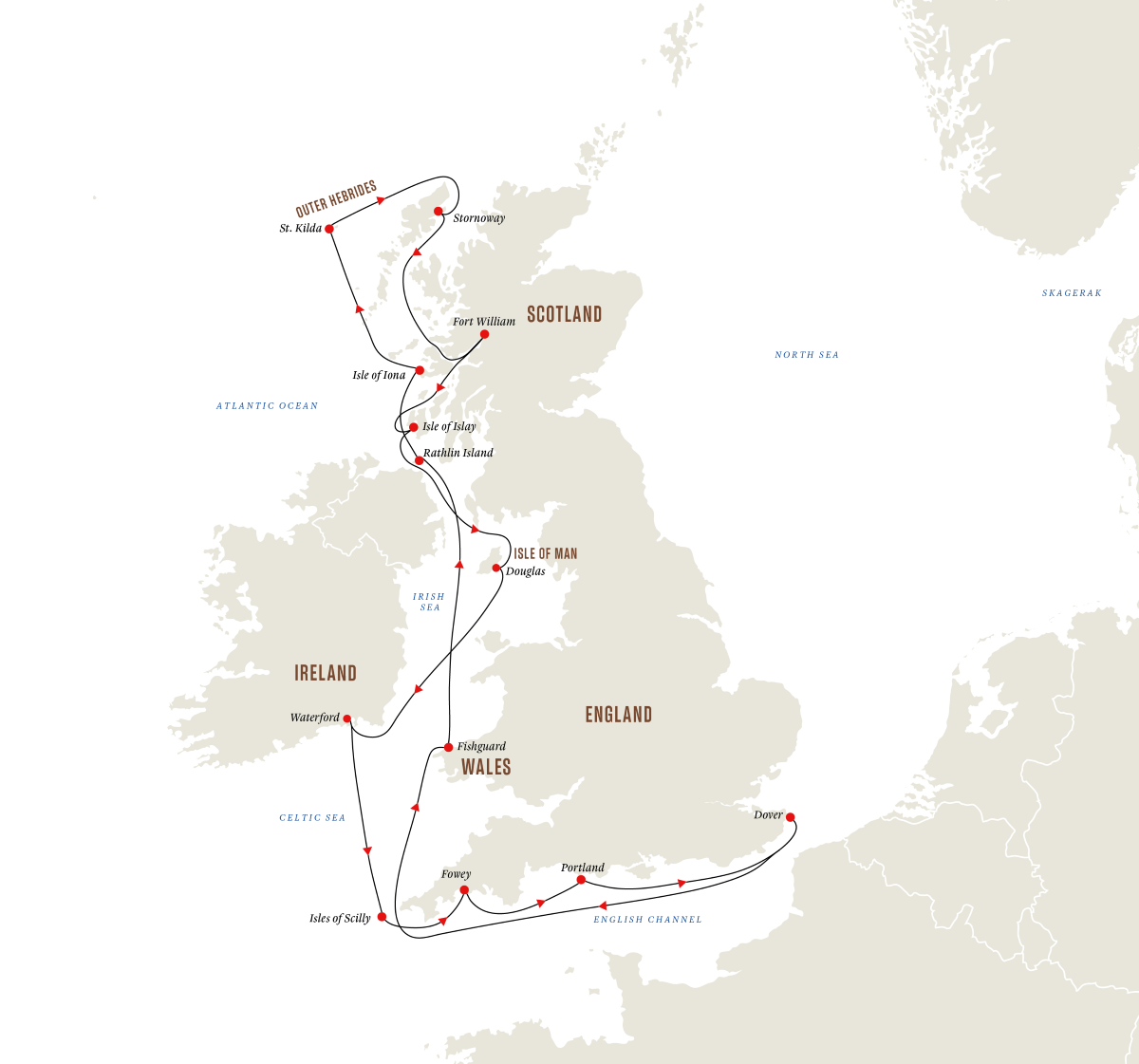
DAY 1 - DOVER, ENGLAND
Your voyage begins
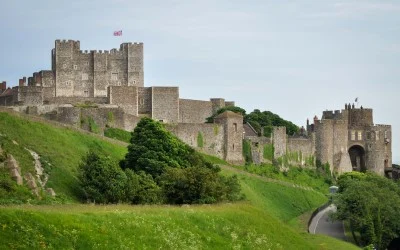
Before joining your ship today, perhaps take some time to explore the coastal town of Dover with its magnificent, medieval castle.
Your comfortable expedition ship MS Maud will be ready and waiting for you in the port of Dover. Once you board the ship and check-in, you’ll receive your complimentary wind and water-resistant expedition jacket which may come in handy with the unpredictable weather. There’ll be time to settle into your cabin and explore a bit of the ship before attending a mandatory pre-departure safety drill.
And with that, we’ll be away! MS Maud will set sail from Dover, making our way along the south coast, bound for an adventure all the way up to Hebrides, around the diverse islands and coastline of the British Isles and beyond.
You’ll be greeted by your friendly and energetic Expedition Team. They’ll prepare you for the exciting days ahead, but their first priority will be to take you through important health and safety principles to ensure you and your fellow explorers are always safe and well throughout your cruise.
Stretch your newly-found sea legs out on deck and get to know the different areas of the ship, your new home away from home for the next 13 days. Enjoy your first dinner aboard the ship and look forward to many more delicious meals to come. Raise your glass and join the Captain and crew as they toast to an enjoyable expedition together.
Please note, as this is an expedition cruise, the order of stops may change due to local circumstances.
DAY 2 - SEA DAY
Relax and learn
Enjoy an idyllic day at sea with plenty to do. You’ll have plenty of time to unwind and really get into the mood for this expedition cruise. Admire the views from MS Maud’s expansive Observation Deck, settle into a good book together with a freshly baked pastry from the Fredheim restaurant, or take full advantage of the gym and hot tubs.
You’ll also be invited to talks hosted by the Expedition Team, experienced explorers who will happily share their extensive knowledge of the British Isles with you. Topics will change each day and often be relevant to the area you are sailing in so today you might be learning about Welsh history or the Pembrokeshire coast. These added insights will enhance your experience, filling out your sense of discovery with delicious detail. Our professional onboard photographer will also be available to give top tips and tricks for the best landscape and wildlife photos.
DAY 3 - FISHGUARD, WALES
Quaint villages and prehistoric forts
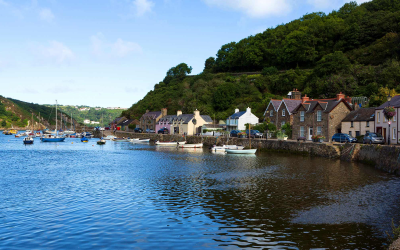
Our first port of call on our exploration of the British Isles, between the Preseli Hills and the Pembrokeshire coast, is the charming fishing village of Fishguard. Split in two by a steep, winding hill, Lower Town is home to the original hamlet and harbour, while the ‘new’ town sits on a clifftop, commanding spectacular views.
Fishguard has the accolade of being the infamous site of the ‘Last Invasion of Britain’, by the French in 1797. The local library houses a 100-foot-long commemorative, ‘Bayeux’ style tapestry, depicting the invasion.
From Lower Town, you can explore the ancient woodlands of the Gwaun Valley that stretch towards the Preseli Hills. Follow a walking trail that takes in the River Gwaun, medieval Llanychllwydog pillar stones, St Brynach’s Church and the Dyffryn Arms pub, run by local legend Bessie. If you appreciate beautiful, landscaped gardens, then head towards the gardens at Dyffryn Fernant.
On the outskirts of Fishguard, you can walk up the hill to Castle Point to the ruins of Fishguard Fort, for incredible views overlooking the harbour. From here, you can also enjoy a walk along a stretch of the Pembrokeshire Coast Path.
Further west of Fishguard, you can take a walk along a stretch of the coastal path on the Pencaer Peninsula, looking out to Strumble Head lighthouse. It’s also a great place for spotting seabirds, seals and porpoises.
The area is also home to a number of Iron Age hillforts, settlements and Neolithic burial mounds. About 30 minutes from Fishguard, you’ll find
the reconstructed roundhouses of Castell Henllys, where costumed guides share the history of the local Demetae tribe.
DAY 4 - RATHLIN ISLAND, NORTHERN IRELAND
Seabirds, choughs and corncrakes
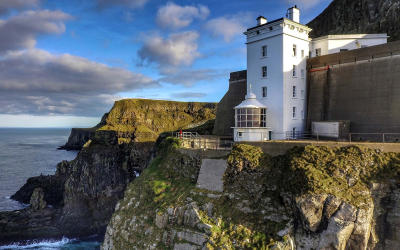
Sitting just off the north coast of County Antrim, with rugged cliffs, lakes and vast, natural grasslands, Rathlin Island boasts Northern Ireland’s largest seabird colony.
At just six miles long and one mile wide, this L-shaped island, home to just 140 inhabitants, is ideal for exploring by bike or on foot. Choose from scenic clifftop walks or the many rambler trails where you can admire the natural beauty and enjoy the tranquillity. Stroll to Mill Bay where you might catch seals frolicking in the water or basking on the rocks.
Visit the RSPB Seabird Centre and the working “upside-down” lighthouse perched on the cliffs. Here, you’ll enjoy close-up views of the seabird colonies, as well as spectacular coastal panoramas.
From late April to July, tens of thousands of seabirds congregate on the island to breed, including puffins, guillemots, kittiwakes, Razorbills and fulmars. Rathlin Island is also home to Northern Ireland's only pair of breeding Choughs, and more recently, the calls of the secretive Corncrake have been heard here for the first time in 30 years.
Pay a visit to the Boathouse Visitor Centre to learn about island life, local history, and the many historical shipwrecks that lie in the waters. Local legend has it that when Robert the Bruce took refuge on the island in 1306, he was inspired by the sight of a spider to return to Scotland and fight for his crown.
Just a short ferry ride and drive away, is the UNESCO World Heritage site of the Giant’s Causeway, Northern Ireland’s top attraction.
It’s a mesmerising sight - 40,000 interlocking hexagonal basalt columns, formed through volcanic activity over 60 million years ago.
DAY 5 - ISLE OF IONA, SCOTLAND AND STAFFA, SCOTLAND
Pilgrims and puffins
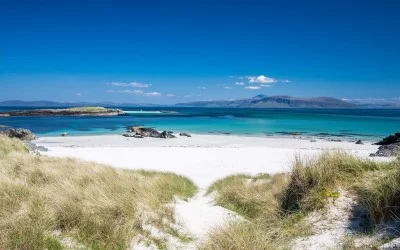
Famed for its mystical Christian associations, Iona is a peaceful little island off the coast of Mull in the Inner Hebrides. The restored Abbey remains a place of pilgrimage and peace, but there’s much more to see here including picturesque beaches, wonderful wildlife and the beautiful St Columba’s Bay.
Iona has been a centre for Christian worship since the sixth century, but the Abbey was sacked several times by Vikings between 795 and 825. Today you can explore this sacred site, including the restored church. There’s said to be 48 early Scottish kings buried in the graveyard, as well as Irish and Norwegian kings – see if you can find them!
There’s a popular hike uphill to Dun I (pronounced Dun Eee) from the Abbey. At the top, you’ll be at Iona’s highest point and will be able to see St Columba’s Bay and the Treshnish Isles. While you’re up there, look out for ‘Natural Well’ aka the ‘Well of Eternal Youth’ and splash your face with its allegedly miraculous waters. It’s in a cleft between two rocks as you walk downhill facing North.
From here, we head towards the remote beauty of the Treshnish Isles, a group of distinctive skerries home to a wealth of wildlife, including nesting Atlantic Puffins, colonies of Black-legged Kittiwakes, Razorbills, and Common Guillemots, as well as and Atlantic grey seals.
Fingal’s Cave, immortalised in music by Mendelssohn’s Hebrides Overture, is on the cave-riddled island of Staffa and is noted for its amazing natural acoustics. The basalt columns within are a northern extension of the Giant’s Causeway in Northern Ireland. On a calm, clear day, it might even be possible to land and see the colour of the waters inside the cave, but its rising columns can also be viewed from the sea.
DAY 6 - ST. KILDA, HIRTA ISLAND, SCOTLAND
UNESCO treasure, reclaimed by nature
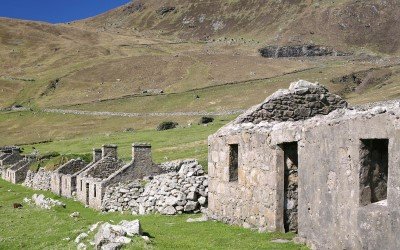
There’s only one way to describe tiny, rocky St Kilda: wild. As such, our visit to this storm-tossed archipelago, with its breathtaking sea cliffs and boiling seas, is totally weather-dependent.
As a UNESCO double World Heritage Site and the ‘jewel in the crown’ of the National Trust for Scotland, visiting St Kilda is an unforgettable experience. The outlying stacks and islands, which are the remains of a volcanic crater, provide ledges for thousands of nesting seabirds. What’s more, it’s frequented by Minke whales. If you’re lucky, you may catch sight of one in the swirling waters surrounding the rocky outcrop. Once home to Britain’s most remote island community, in 1930, after 4,000 years of continuous habitation, the people living on St Kilda’s Hirta Island were evacuated at their own request. The tiny museum that remains is a record of how hard life was on this exposed outcrop.
However, setting foot on St Kilda you’ll soon see the island is far from deserted – it’s home to a multitude of seabirds, including over 60,000 pairs of Northern Gannets – the second largest gannet colony in the world! There’s a good chance you’ll spot many other seabirds, including Atlantic Puffins, Northern Fulmars, Common Guillemots, and Black-legged Kittiwakes. It’s why St Kilda is considered one of the most important seabird colonies in Europe.
Birdlife aside, you might see other island inhabitants if you look. An ancient breed of sheep – the Soay sheep – lives wild here, as do a number of other rare species including the St Kilda mouse and the St Kilda Wren. See if you can find any of them!
Explore the abandoned village and see the distinctive ‘cleits’ – circular stone buildings used to store peat, eggs and smoked puffins, before heading back to the ship and our rather less primitive dining options.
DAY 7 - STORNOWAY, LEWIS, SCOTLAND
Capital of the Outer Hebrides
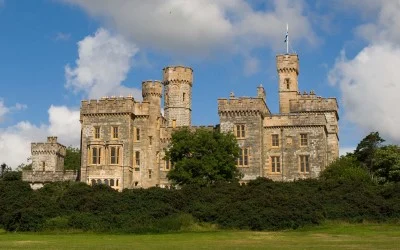
Stornoway is the capital of the Isle of Lewis & Harris, an island famed for its pristine beaches, Neolithic sites and tweed workshops. Be prepared to step back in time as you investigate ancient ruins and gaze in wonder at the mysterious Callanish standing stones, as well as exploring the bustling waterfront and streets of island’s main town.
Originally a Viking settlement, Stornoway is the main town on Lewis & Harris – a single island with two names, denoting the north and south parts. It’s the largest and most northerly island in the Outer Hebrides, aka the Western Isles. Check out Lews Castle, an impressive Gothic-revival style which overlooks Stornoway harbour. As well as visiting its museum, you can wander round the grounds and get unbeatable views of the inky blue seas. Or why not drop in for a wee dram in the castle’s very own whisky bar.
Harris is famed for its woollen tweed fabric, and you’ll see jackets, trousers and hats for sale in shops all over the island – perfect for gifts or mementos. After visiting shops, museums and old castles, blow the cobwebs off with a walk.
Of course, a visit to Lewis & Harris wouldn’t be complete without seeing the Callanish standing stones (Calanais in Gaelic), a magical ring of monoliths whose origins are shrouded in mystery. Another atmospheric site is the Blackhouse at Arnol, a completely restored thatched traditional dwelling which provides a fascinating glimpse into the past.
If you fancy a walk, there are many routes to pick from, with Lewis being the less hilly part. As you explore the island, look out for red deer, eagles, otters, gannets and butterflies – the wild side of this peaceful island attracts nature lovers from around the world.
DAY 8 - FORT WILLIAM, SCOTLAND
Scottish Highlands
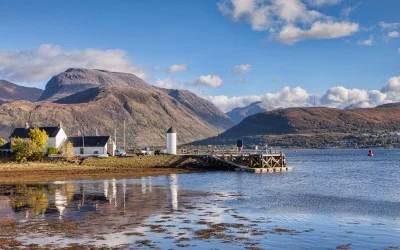
We sail into Loch Linnhe and enjoy the beautiful environs of its mountains, islets, estuaries and lochs. We anchor at the highland town of Fort William, dominated by the views of Ben Nevis, the UK’s highest mountain. Known as the Outdoor Capital of the UK, with some of the most spectacular Highlands scenery in Britain, it’s an ideal location from which to explore the area.
Around Fort William High Street are several local points of interest like pretty St Andrew's Church, St Mary's Church, and the West Highland Museum. While the museum may appear small, you’ll discover a fascinating archive of local history, crammed full of artefacts documenting the Jacobites, commandos stationed here in WW2 and highland life. And, of course, there’s the now-familiar local whisky distillery, offering its own take on the national tipple.
A short drive away is Glen Nevis, offering one of the best short walks in Scotland: a four-mile scenic loop that starts in a secluded valley, opens up into the dramatic and beautiful Nevis Gorge, and takes in the raging rapids of the stunning Steall Falls.
On the shores of Loch Shiel, you’ll find the village of Glenfinnan, surrounded by mountains. It was the site of the second Jacobite Rising in 1745, where Bonnie Prince Charlies led 1,200 Highland clansmen to battle. More recently, the iconic arches of Glenfinnan Viaduct, that rise 100 feet off the ground, were made famous in the Harry Potter movies when the ‘Hogwarts Express’ steam train passes over the viaduct.
Other attractions in the area include the 60-mile-long Caledonian Canal, and Glen Coe, formed from volcanic activity, sculpted by glacier and designated an area of outstanding natural beauty.
DAY 9 - ISLAY, SCOTLAND
Scottish island life, distilled
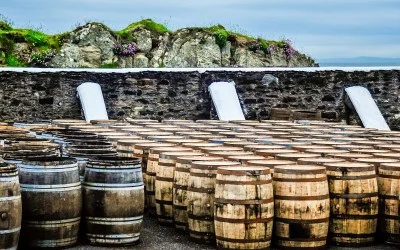
Fire up your spirit of adventure and step onto an island famed for its whisky, wildlife and woolly garments.
Islay isn’t called ‘whisky island’ for nothing. There are nine working distilleries here, and you’ll find their peaty single malts sold around the world. One of the larger isles, there’s 130 miles of coastline here, and numerous quiet, sandy beaches. Superb cliff-top walks await, and there’s a rather beautiful and famous yet difficult golf course on the Oa Peninsula.
History abounds on Islay, with standing stones and a stone circle showing the island was inhabited back in Neolithic times. Islay was later known as the Lordship of the Isles, and you can explore the enigmatic settlement at Finlaggan, which remains the most important archaeological site on the island, while a number of Celtic crosses can be found dotted around.
Islay is a wildlife paradise, with over 200 species of birds including oystercatchers, gannets, terns, and cormorants, as well as buzzards, Hen Harriers and even White-tailed Eagles. From the beaches, dolphins and basking sharks are sometimes spotted, and you might even see otters if you are patient.
Delve into the delights of the charming little town of Bowmore where there’s shops, an interesting round church, plus several cosy pubs and restaurants. It’s probably the only place in the world you can grab a Hebridean pizza – or ‘peat-za’ – topped with crab and lobster.
Arts and crafts abound in Bowmore, and you can visit potters, quilters and artists in their workshops. Visit Islay Woollen Mill, near Bridgend, which made tartan clothes for Mel Gibson in Braveheart, as well as Liam Neeson’s kilt in Rob Roy.
Of course, no trip to Islay would be complete without a visit to at least one of its famous distilleries. Bruichladdich, Laphroaig, Bunnahabhain, Ardbeg and Bowmore are among the best known.
DAY 10 - DOUGLAS, ISLE OF MAN
Viking history on a Celtic island
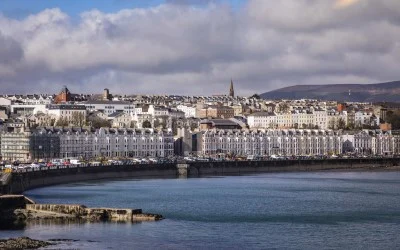
Bring your camera and head out on deck as we sail in to Douglas – the scenic approach is not to be missed! We pull up alongside the capital of the Isle of Man, a quirky island that’s full of character. Learn about the island’s Celtic and Viking heritage, trace its development as a Victorian tourist resort, or discover its stunning rugged coastline.
In recognition of its diverse marine and coastal ecosystems, and socio-economic characteristics, the Isle of Man has been designated a UNESCO Biosphere Reserve, ‘a learning place for sustainable development’. Discover the geology, marine life and maritime history of its shorelines on the island’s three Blueways Trails.
The island is a treat for railway and motorsport enthusiasts. Every year, the island becomes a mecca for motorcyclists, as hosts of the TT races. You can hop on board an historic steam train, a vintage electric tram, or horse-drawn tram. Or visit the local Motor Museum and Motorcycle Museum.
In Douglas, get an overview of the island’s history at the Manx Museum, enjoy a stroll through the town and local surrounds at your leisure, and pop into St Thomas’ Church to see the unique and colourful Nicholson Murals.
Nearby, the rocky outcrop of Douglas Head overlooking the harbour, has some of the best views of the island. Look for the Tower of Refuge in Douglas Bay, originally built as a sanctuary for shipwreck victims. Then visit the unusual Grand Union Camera Obscura, that’s been a tourist attraction since 1892.
Across the island from Douglas, you can visit the impressive Peel Castle. Originally, the stronghold of Viking King Magnus Barelegs in the 11th century, it was later run by Christian missionaries, and is rumoured to be haunted. From the castle, seals and basking sharks can occasionally be spotted.
DAY 11 - HOLYHEAD, WALES
Exploring the Isle of Anglesey
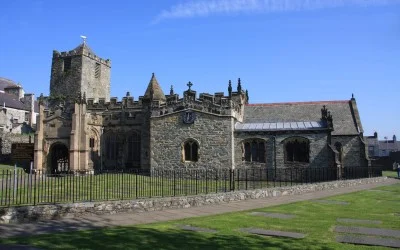
Holyhead is an ideal destination for us to explore the charm and history of North Wales, whether on foot or by car. Enjoy a visit to Holyhead Breakwater Country Park with its wildlife and industrial exhibitions, lake Llyn Llwynog and explore the Rocky Coast. Renowned for its lighthouse and large colonies of seabirds South Stack island is also home to the RSPB visitor centre in Ellins Tower. Why not walk part of the Isle of Anglesey Coastal Path exploring the sea cliffs and enjoying magnificent views stretching across to Ireland. Head back into the ancient town centre, built around Saint Cybi’s Church which dates back to 550AD and stands on the site of a Roman fort with the original fort wall still surrounding it. Holyhead Maritime Museum, located at the oldest lifeboat station (dating back to 1858), showcases an enthralling maritime history and is amongst just some of the historical interest in this charming town. Before heading back to the ship take a stroll around the town and be sure to enjoy some traditional Welsh cakes at one of the many local cafés.
*Due to port congestion, 1 August voyage will overnight in Douglas (Isle of Man) where you will have the opportunity to enjoy the delightful seaside town in the evening and spend an extended time ashore. The following day will be spent at sea making our way towards the Isles of Scilly whilst our onboard team of experts will prepare you for the upcoming days as well as share their vast knowledge of the destinations visited.
DAY 12 - ISLES OF SCILLY, ENGLAND
Beauty, history and brimming with wildlife
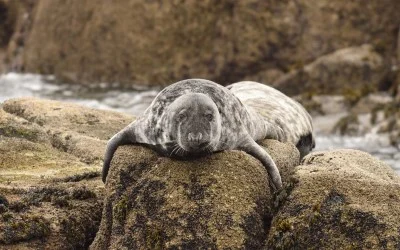
This enchanting archipelago 30 miles off the tip of Cornwall is home to outstandingly beautiful, uncrowded and unspoilt islands and islets. It’s been likened to a tropical paradise, but the waters around it can also be choppy. If sea conditions and weather allow, we will spend the day here. Covered in heathland, with magnificent sandy beaches, the islands are surrounded by turquoise waters and reefs and offer picturesque coastal walks.
Ideal for exploring on foot, the island of Tresco is home to the famed Tresco Abbey Gardens with its 20,000 plants, many of them subtropical species. You can also explore the castle ruins, the Valhalla Museum – which contains a quirky collection of ships’ figureheads – or stroll along the white sandy beaches. Should conditions allow, we aim to do a beach clean-up on this charming island.
We will split our time in the area, and you may also choose to visit St Mary’s – the largest of the islands – with its rocky coves, archaeological sites and charming Hugh Town. Explore the town and sample some of the freshly caught seafood whilst enjoying the delightful views of the island.
There are many more things to see and do on St Mary’s, including visiting the Phoenix Craft Studios, which is a cooperative of individual artists and makers, checking out the Tamarisk Gallery, or dropping in on the Longstone Café for a cream tea or a spot of lunch.
Alternatively, join one of our optional landings for a trip around the islands, visiting shipwreck sites, spying seals lying on the rocks, as well as cruising around the bird sanctuary of Annet to observe the puffins and numerous other breeding seabirds.
DAY 13 - FOWEY, ENGLAND
Riverside Exploration
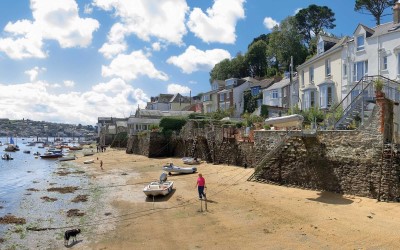
Set in an Area of Outstanding Natural Beauty, the beautiful, historic harbour town of Fowey rests on the west side of the Fowey Estuary, a flooded valley cut by meltwater after the last Ice Age.
Explore this delightful location on foot and wander down to the panoramic Gribbin Head on the west side where the Gribbin Headland Daymark went up in 1832 as a navigation aid. There are many other walks available, including the “Hall Walk” along the Pont Pill creek or along the esplanade to Readymoney Cove and St Catherine’s Castle.
DAY 14 - PORTLAND, ENGLAND
Birders Paradise
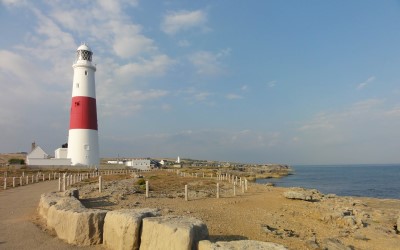
Located at the centre of the UNESCO World Heritage Jurassic Coast, an area renowned for its natural beauty and historical heritage, Portland is a destination bursting with intrigue and history. With quiet coves, disused quarries, a rich and fascinating history with some of the best views in Britain as well as being a haven for wildlife.
A tied island, the Isle of Portland is situated on the southernmost point of the county of Dorset. A barrier beach called Chesil Beach joins Portland to the mainland and the resort town of Weymouth. With nearly 300 species of bird, over 30 species of butterfly and 720 species of moth, Chesil Beach and the Fleet lagoon are of international conservation importance. As a significant migrating point for birds, Portland provides bird watching enthusiasts with the prospect of glancing rare species.
DAY 15 - DOVER, ENGLAND
Return to England
We pass the white cliffs of Dover during the early morning hours and dock at the city’s harbour. After breakfast, it’s time to leave your home for the past couple of weeks.

